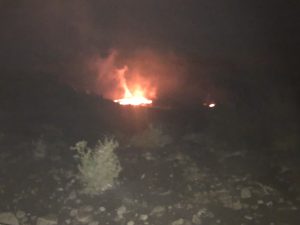
Fire Memoir
October, 1996
Just before dinner Bob and I were paged to respond to a fire on the slopes of Mauna Kea. Several ranches were threatened, along with a small subdivision, downwind. The winds were raging northeast trades and we knew we’d likely be gone most of the night. Bob threw our gear in the jeep, I filled water bottles, grabbed the first aid kit and we headed for Mana Road, about fifteen miles away. There, we’d meet the tanker, the brush truck, and the rest of the volunteers.
In the darkness, the fire is at once beautiful and terrifying. It looks to me like the volcano is erupting along a rift zone, but the orange rivers of lava turn out to be burning grasses and shrub. The dry wind howls through the saddle between the mountains, driving the flames down toward the coast. Embers streak by us like galaxies of sparks.
Ralph Saito, our chief wearing a white hard hat, gets instructions from the Incident Commander, then relays to us and assigns us our tasks. Sometimes we’re pulling hose for the career guys, sometimes we’re on our own — putting down hot spots, holding a fire line. We’re a group of mostly middle-aged civilians — men and women — and we work hard, without a break, for as long as it takes to get the job done. (And to think when I joined this newly formed volunteer company, I assumed I’d be organizing bake sales – Ha!)
I am glad for my bunker jacket; Hawaii ain’t all beaches. It’s shivering cold tonight, at 3000 feet elevation. Bob and I work alongside Susan, Paul, and Jerry, maintaining a break, then hosing down an evacuated house with water from our tanker and our brush truck.
Around midnight, the wind takes a rest and so do we. Hot food is brought to us in the fire chief’s vehicle — complements of a local plate lunch restaurant. So good! We get orders to stand down, refill the tanks, and go home for some rest while the career firefighters keep on through the night…
That fire was under control, though it would smolder for days. At night, the cool air sunk toward the sea, carrying with it the smell of ash and smoke. We remained on call, our pagers blinking green in the night.
***
Wildfires in Hawaii are not new — especially on the dry leeward sides of mountainous islands. Lightening is seldom a cause, here. More often, fires are started from discarded cigarettes and matches, open campfires, sparks from vehicles igniting dry grasses. Lava flows have also started brush fires and trade winds fan them with terrifying speed.
Strong trade winds are no stranger to these Pacific islands; they can combine with dry conditions to form a “perfect firestorm.” Well-trained professionals are accustomed to protecting life and property, using engines, tankers, brush trucks, bulldozers, helicopters with buckets. Still, the Hawaiian Islands are some of the most remote human habitations in the world. Sometimes our technology and resources are not enough — especially on an isolated island. In the recent debacle on Maui and the Big Island some people evacuated their homes, as per Civil Defense instructions. Some stayed at home and tried to protect their property. Some went into the ocean to save themselves. Over one hundred people died.
***
For more than a decade Bob Russell and I were volunteers with Hawaii County’s North Kohala Coast Company 14-A. Together, with about two dozen other neighbors and friends, we were under the guidance of the professional firefighters of Hawaii County. I taught first aid and CPR and I learned firefighting techniques like donning SCBA, how to lift and carry an unconscious person, how NOT to enter a burning building. The experience has given me much respect and gratitude for those who responded to the recent devastating wildfires that consumed Lahaina, Maui County, and caused much damage on Hawaii County.
My sympathies to the families of those who lost loved ones in the recent fires and my deep gratitude for all those who responded — professionals, volunteers, residents, and bystanders.
We all live on an island, this island Earth. Aloha pumehana kakou